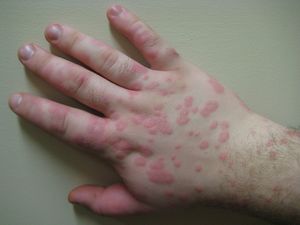We need you! Join our contributor community and become a WikEM editor through our open and transparent promotion process.
Erythema multiforme
From WikEM
(Redirected from Erythema Multiforme)
Contents
Background
- Erythema Multiforme (EM) is an acute, self-limited skin condition
- Peak incidence in second and third decades of life
- Despite multiple associations, thought to be triggered by HSV in most cases
- Usually self-limited and resolves within 2-6 weeks; may recur
- Wide spectrum of severity
- Classified as Erythema multiforme minor or Erythema multiforme major
Precipitants
- Infections:
- Viral: HSV, hepatitis, influenza A
- HSV responsible for ~70% of cases, making it the most common etiology[1]
- Fungal: dermatophytosis, histoplasmosis, coccidioidomycosis
- Bacterial: streptococcus, mycoplasma, tuberculosis
- Viral: HSV, hepatitis, influenza A
- Drugs:
- Antibiotics (penicillin, sulfonamides), anticonvulsants (phenytoin, barbiturates), NSAIDS, aspirin, antituberculous meds, allopurinol, etc.
- Collagen Vascular Disorders:
- RA, SLE, dermatomyositis, polyarteritis nodosa
- Others:
- Pregnancy, cold weather, sunlight, contact exposure, foods, malignancy, hormonal
Clinical Features
- Erythematous or violaceous macules, papules, vesicles, or bullae
- Target lesions with “three zones of color” are the hallmark of EM
- Distribution is usually symmetric, most commonly involving palms/soles, the backs of the hands/feet, and/or the extensor surfaces of the extremities
- Not to be confused with SJS/TEN, which are now considered separate from the EM spectrum
Erythema multiforme minor
- Typical targets or raised, edematous papules distributed peripherally
- No mucous membrane involvement
Erythema multiforme major
- Same as EM minor + involvement of 1+ mucous membranes
- Epidermal detachment involves < 10% of total body surface area
- Some cases can be severe or even fatal
Differential Diagnosis
- Fixed drug reaction
- Stevens Johnson Syndrome and Toxic Epidermal Necrolysis
- Subacute cutaneous lupus erythematosus
- Urticaria
- Viral exanthems
- Allergic or irritant contact dermatitis
Vesiculobullous rashes
Febrile
- Diffuse distribution
- Varicella
- Smallpox
- Disseminated gonococcal disease
- DIC
- Purpural fulminans
- Localized distribution
Afebrile
- Diffuse distribution
- Bullous pemphigoid
- Drug-Induced bullous disorders
- Pemphigus vulgaris
- Phytophotodermatitis
- Erythema multiforme major
- Localized distribution
- Contact dermatitis
- Herpes zoster
- Dyshidrotic eczema
- Burn
- Dermatitis herpetiformis
- Erythema multiforme minor
- Poison Oak, Ivy, Sumac dermatitis
- Bullosis diabeticorum
Evaluation
- Usually made clinically
- In severe cases, work-up includes basic labs and cultures
- Punch biopsy: to confirm the diagnosis and to rule out other diagnoses (looks different from SJS/TEN histologically)
Management
- Search for underlying cause
- Prompt withdrawal of suspected drug/agent causing symptoms
- Symptomatic treatment
- Oral antihistamines, analgesics, local skin care
- If oral involvement: soothing mouth washes
- If eye involvement: topical lubricants, cleaning of conjunctiva, and removal of fresh adhesions
- Mild cases with localized lesions, may consider topical corticosteroids. Use of systemic steroids is controversial
- Consultation (rarely) with the following may be necessary: dermatologist, ophthalmologist, burn surgeon
Disposition
- For mild cases, treat as above with dermatology follow-up
- For severe cases with multiple lesions / severe mucous membrane or tracheobronchial involvement with impaired PO intake, dehydration, or secondary infection: inpatient admission
- May require specialized ICU or burn unit care
See Also
External Links
References
- Plaza J, Prieto V. Erythema Multiforme. Medscape fromWebMD. Sept 2014
- Rosen’s Emergency Medicine
- http://www.ncbi.nlm.nih.gov/pubmed/25059772
- http://www.ncbi.nlm.nih.gov/pubmed/18723713
- Image source: Weinberg A, Prose N, Kristal L. Color Atlas of Pediatric Dermatology. McGraw-Hill Companies, Inc. Copyright 2008, 1998, 1990, 1975
- ↑ Lamoreux MR, Sternbach MR, Hsu WT (December 2006). Erythema multiforme. Am Fam Physician 74 (11): 1883–8. PMID 17168345


